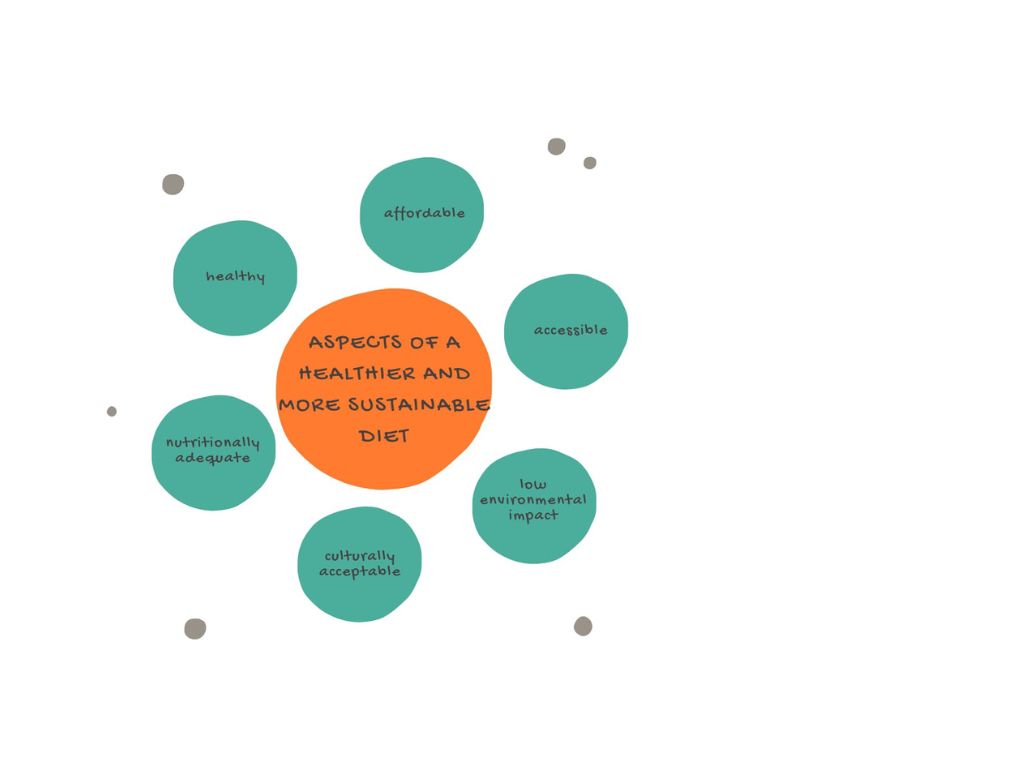How can we all eat a healthier and more sustainable diet?
Written by Dr Simon Steenson, Nutrition Scientist at the British Nutrition Foundation.
What changes can we make to our diets to improve our own health, whilst also lowering the environmental impact of the food we eat? Shifting to a healthier and more sustainable way of eating might seem like an impossible task, but there are some areas we can focus on to make positive changes – for our health, and the health of our planet.
Read on to find out more about what is a healthy and sustainable diet, and why a healthy diet is important.

Why do we need to change the way we eat?
Poor quality diets are responsible for 1 in 5 deaths globally1, and malnutrition remains one of the most pressing public health issues globally. Close to 2 billion adults are living with overweight and obesity, yet almost half a billion remain underweight1.
Our current food system is also a major driver of environmental change and is responsible for about one-third of all global greenhouse gas emissions, close to three-quarters (70%) of freshwater use, and about 40% of land use2-6. The global food system is also a primary driver of biodiversity loss7. So, there is a clear need for large-scale changes to protect both human and planetary health.
What do we mean by a ‘healthy and sustainable’ diet?
The word ‘sustainable’ and the emphasis on being more sustainable become commonplace these days, but when it comes to food there are a wide range of factors that we need to consider if we want our diets to be truly sustainable (see Figure 1). Sustainable living means not just thinking about our carbon footprint, but also whether foods are affordable, accessible, culturally acceptable and, of course, nutritionally adequate and healthy8.
Knowing how to balance out all these factors to give practical dietary advice can be a real challenge. However, there are some actions we can all take to benefit our own health and that of the planet6.

Figure 1. Aspects of a ‘sustainable’ diet mentioned within the FAO definition published in 2012.
What changes do we need to make to our diets?
It’s important to stress that there is no ‘one-size-fits-all’ solution to sustainable and healthy eating6,8. We are all different and we all have different needs – whether they are related to our nutritional requirements, our food budget or ability to access certain foods, or our personal or cultural preferences.
The good news, though, is that there are some broad areas where we can look to make positive changes to align our diets more closely with the Eatwell Guide – the UK’s healthy eating model.
It is estimated that if everyone in the UK followed the Eatwell Guide more closely, this would not only improve our health but also reduce the greenhouse gases (-30%) and water use (-4 to -7%) linked to our current diets9. However, at the moment, only 30% of people in the UK achieve at least 5 out of the 9 Eatwell Guide recommendations, and a mere 0.1% achieve all 9 recommendations9.
So, where can we look to do better?
1. Eat more fruit and vegetables
An essential component of a healthier and more sustainable diet, although only a third of UK adults manage to eat at least 5 portions (80 grams each) a day10.
A few ways we can get more fruit and veg into our diets include:
- Snacking on fruit throughout the day
- Adding extra fresh, frozen, or canned veg into recipes
- Topping breakfast cereal with a sliced apple, banana, kiwi, or a handful of frozen fruit.
2. Vary our choice of protein foods
While we don’t need to cut out meat, fish, eggs or dairy foods completely to have a healthier and more sustainable diet, we should look to rebalance our protein sources in favour of more beans, peas, lentils (and other legumes), nuts and seeds, as well as other alternative protein sources6.
An ever-growing range of products is now available from supermarkets, made using alternative protein sources, including soya, pea protein, mycoprotein and others. These can be an easy substitute for popular meat products in a variety of dishes. For example, mycoprotein is available in a range of products suitable for vegetarians and, in some cases, also for vegans, which can be used as a replacement for mince, chicken, sausages or other foods. Mycoprotein is a protein-rich, high-fibre food that provides a source of riboflavin, and is high in folate, phosphorus, zinc, and manganese. It is produced via fermentation from a type of fungus that occurs naturally in the soil11.
3. Limit foods high in fat, salt, and sugar
We all know that foods like cakes, biscuits, sweets, and pastries are not the healthiest choices, but these also contribute to the greenhouse gases, land and water use associated with our diets – especially if these make a large contribution to our overall dietary energy intake6. So, having these less often and in smaller amounts is a win-win for our health and the planet too.
4. Choose sustainable sources of fish and seafood
Fish provides not only protein, but also vitamins and minerals, and long-chain omega-3 fats that can benefit heart health. Healthy eating guidelines in the UK recommend that we eat at least two 140-gram portions of fish per week (one portion should be an oily fish, like sardines or salmon). However, about a third of global fish stocks are currently overfished12, so choosing products with the blue MSC or green ASC certifications can help support a more sustainable seafood industry13.
5. Waste less food (and drinks)
Food that is lost in the supply chain or wasted by us as consumers accounts for 8 to 10% of all greenhouse gases due to human activity, and about half of all emissions from our global food system4. Despite this, only about 4 out of 10 UK adults make a clear connection between wasting food and climate change13. Reducing food (and drink) waste is an essential part of more sustainable eating, whichever type of diet we choose. It is also estimated that cutting out food waste would save the average UK household with children around £60 a month15 – that’s a lot of money not going in the bin! In the current economic climate, being mindful about the importance of sustainability as we do our shopping and meal planning is key.
Here are a few things we can do:
- Plan ahead and make a list before shopping – this can help us only buy what we really need.
- Know your date labels – foods are still OK to eat past their ‘best before’ date (which is about food quality) but can’t be eaten after their ‘use-by’ date (which is for food safety).
- Use up leftover ingredients – for example, make a ‘back of the fridge’ soup or find ways to combine leftover rice, pasta, salad or other ingredients into new dishes.
- Batch cook and freeze any leftovers - gives you a healthier meal when you’re too busy to cook. Remember to label meals to avoid any ‘UFOs’ (unidentified freezer objects!).
- Use food waste apps that offer surplus food at a discount – a great way to bag a bargain and help businesses cut down on waste too.
Small changes, big difference!
Changing our diets to be healthier and more sustainable might seem daunting or complex at first. But, it’s important to remember that focussing on the some of the areas where we are able to make small changes can all add up to make a real difference – especially when we all do them together!
References
1 Afshin, A., Sur, P.J., Fay, K.A., Cornaby, L., Ferrara, G., Salama, J.S. et al. (2019) Health effects of dietary risks in 195 countries, 1990-2017: a systematic analysis for the Global Burden of Disease Study 2017. The Lancet, 393(10184), 1958-1972.
2 Crippa, M., Solazzo, E., Guizzardi, D., Monforti-Ferrario, F., Tubiello, F.N. & Leip, A. (2021) Food systems are responsible for a third of global anthropogenic GHG emissions. Nature Food, 2(3), 198-209.
3 FAO (Food and Agriculture Organization of the United Nations). (2020a) News: Land use in agriculture by the numbers. Rome: Food and Agriculture Organization of the United Nations (FAO). Available from: http://www.fao.org/sustainability/news/detail/en/c/1274219/ [Accessed 16 July 2021].
4 IPCC Special Report on Climate Change and Land (2019). Chapter 5: Food security. https://www.ipcc.ch/srccl/chapter/chapter-5/ s
5 UN (United Nations). (2019) World Population Prospects 2019: Highlights. Department of Economic and Social Affairs, Population Division, United Nations, New York, US. https://population.un.org/wpp/Publications/Files/WPP2019_Highlights.pdf
6 Steenson, S. & Buttriss, J.L. (2021) Healthier and more sustainable diets: What changes are needed in high-income countries? Nutrition Bulletin, 46(3), 279-309.
7 UN Environment Programme (2021) Food system impacts on biodiversity loss. https://www.unep.org/resources/publication/food-system-impacts-biodiversity-loss
8 Steenson, S. & Buttriss, J.L. (2020) The challenges of defining a healthy and ‘sustainable’ diet. Nutrition Bulletin, 45(2), 206-222.
9 Scheelbeek, P., Green, R., Papier, K., Knuppel, A., Alae-Carew, C., Balkwill, A. et al. (2020) Health impacts and environmental footprints of diets that meet the Eatwell Guide recommendations: analyses of multiple UK studies. BMJ Open, 10(8), e037554.
10 Bates, B., Collins, D., Cox, L., Nicholson, S., Page, P., Roberts, C. et al. (2019) National Diet and Nutrition Survey Results from Years 1 to 9 of the Rolling Programme (2012/2013 –2013/2014): time trend and income analysis. Public Health England. Available from: https://www.gov.uk/government/statistics/ndns-time-trend-and-income-analyses-for-years-1-to-9
11 Cherta-Murillo, A., Lett, A.M., Frampton, J., Chambers, E.S., Finnigan, T.J.A. & Frost, G.S. (2020) Effects of mycoprotein on glycaemic control and energy intake in humans: a systematic review. British Journal of Nutrition, 123(12), 1321-1332.
12 FAO (2022) The State of World Fisheries and Aquaculture 2022: Towards Blue Transformation. https://www.fao.org/documents/card/en/c/cc0461en
13 Steenson S & Creedon A (2022) Plenty more fish in the sea? – is there a place for seafood within a healthier and more sustainable diet? Nutrition Bulletin 47 (2): 261-273.
14 WRAP Food Waste Trends Survey 2019. https://wrap.org.uk/resources/report/food-waste-trends-survey-2019
15 WRAP Food surplus and waste in the UK – key facts (Updated October 2021). https://wrap.org.uk/sites/default/files/2021-10/food-%20surplus-and-%20waste-in-the-%20uk-key-facts-oct-21.pdf